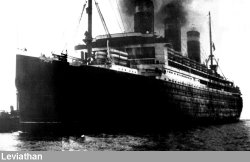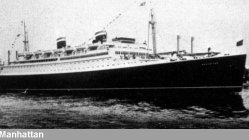

|
       |  In the early years of the twentieth century no major line appeared under the American flag. Much American money was involved in shipping, such as J. P. Morganís ownership of the White Star line, however, White Star was still on the British Register. Of the prominent pre-First World War American lines were, the Dollar Line (later to become the American President Line) and the Moore, McCormack line. But, both of these lines didnít operate on the most glamorous and competitive route, the North Atlantic.
After the First World War, the American Government found herself in the possession of a large fleet of ex-German liners, which included two previous holders of the Blue Riband. Most of the ships had been used as troopers and would require costly refits to bring them into service. The United States Government would provide funds to recondition the largest of these liners, including the monster Leviathan (the ex-Vaterland), and they would go into service for the United States Line, formed in 1921. Under navel architect William Gibbs, the Leviathan was reconditioned and was ready to begin service by 1923. The Leviathan was almost a new ship, able to achieve 27 knots and sporting new, modern interiors. The Leviathan was put on the North In the early years of the twentieth century no major line appeared under the American flag. Much American money was involved in shipping, such as J. P. Morganís ownership of the White Star line, however, White Star was still on the British Register. Of the prominent pre-First World War American lines were, the Dollar Line (later to become the American President Line) and the Moore, McCormack line. But, both of these lines didnít operate on the most glamorous and competitive route, the North Atlantic.
After the First World War, the American Government found herself in the possession of a large fleet of ex-German liners, which included two previous holders of the Blue Riband. Most of the ships had been used as troopers and would require costly refits to bring them into service. The United States Government would provide funds to recondition the largest of these liners, including the monster Leviathan (the ex-Vaterland), and they would go into service for the United States Line, formed in 1921. Under navel architect William Gibbs, the Leviathan was reconditioned and was ready to begin service by 1923. The Leviathan was almost a new ship, able to achieve 27 knots and sporting new, modern interiors. The Leviathan was put on the North  Atlantic run, but was never able to achieve a profit, often sailing half full. This can be partly attributed to the ship emerging in the prohibition years, where American ships were alcohol free vessels, while her competitors, when once free from American waters, could offer the "long bars" so loved in the 1920ís. The ships profits were also affected in the mid-twenties when the United States emigration laws restricted entry into the county. (Wall, 1977:70-73).
The subsidy for the Leviathan was withdrawn in 1929 and control of the line passed to P W. Chapman who had plans for two 45,000 ton ships to replace the Leviathan. But when the economic depression intervened, the line was bought by the International Mercantile Group. The Leviathan was laid up and sold for scrap in 1938, and the United States Line introduced the smaller and more profitable liners Manhattan and Washington, both at 24,000 tons. The largest ship built for America before World War Two was the 34,000 ton America of 1939. Atlantic run, but was never able to achieve a profit, often sailing half full. This can be partly attributed to the ship emerging in the prohibition years, where American ships were alcohol free vessels, while her competitors, when once free from American waters, could offer the "long bars" so loved in the 1920ís. The ships profits were also affected in the mid-twenties when the United States emigration laws restricted entry into the county. (Wall, 1977:70-73).
The subsidy for the Leviathan was withdrawn in 1929 and control of the line passed to P W. Chapman who had plans for two 45,000 ton ships to replace the Leviathan. But when the economic depression intervened, the line was bought by the International Mercantile Group. The Leviathan was laid up and sold for scrap in 1938, and the United States Line introduced the smaller and more profitable liners Manhattan and Washington, both at 24,000 tons. The largest ship built for America before World War Two was the 34,000 ton America of 1939.
 After the war, the American government, having witnessed the success of using the Queen Mary and Elizabeth as troopers during the war, voted a $48 million dollar subsidy to finance their own large high-speed Atlantic liner. Under the guidance of navel architect William Gibbs and his partners, work would begin on the 50,000 ton liner, the United States. The United States would be a technological sensation, the first fire-proof ship, the fastest ship ever produced, convertible to a trooper in a matter of days. On her maiden voyage in July 1952, the United States averaged an amazing 35.59 knots, cutting ten hours from the Queen Maryís best time. The United States would prove herself an unbeatable thoroughbred, but would never been as successful with passengers as her designers hoped. The United States and the America of 1939, operated together until 1965, when falling trade forced the sale of the America. The government subsidy was withdrawn in 1969, and the worlds fastest ship the United States was laid up in Virginiaís Hampton Roads. The United States was eventually be sold and would change hands frequently, it now rests again in American waters, itís rusting hulk a reminder of the long lost days of the Atlantic ferry. ...(bibliography). (american liner gallery). After the war, the American government, having witnessed the success of using the Queen Mary and Elizabeth as troopers during the war, voted a $48 million dollar subsidy to finance their own large high-speed Atlantic liner. Under the guidance of navel architect William Gibbs and his partners, work would begin on the 50,000 ton liner, the United States. The United States would be a technological sensation, the first fire-proof ship, the fastest ship ever produced, convertible to a trooper in a matter of days. On her maiden voyage in July 1952, the United States averaged an amazing 35.59 knots, cutting ten hours from the Queen Maryís best time. The United States would prove herself an unbeatable thoroughbred, but would never been as successful with passengers as her designers hoped. The United States and the America of 1939, operated together until 1965, when falling trade forced the sale of the America. The government subsidy was withdrawn in 1969, and the worlds fastest ship the United States was laid up in Virginiaís Hampton Roads. The United States was eventually be sold and would change hands frequently, it now rests again in American waters, itís rusting hulk a reminder of the long lost days of the Atlantic ferry. ...(bibliography). (american liner gallery).FastCounter by bCentral People have visited this page since; 11/6/96 | Ocean Liners | Links | View Guestbook | Sign Guestbook | E-mail | |